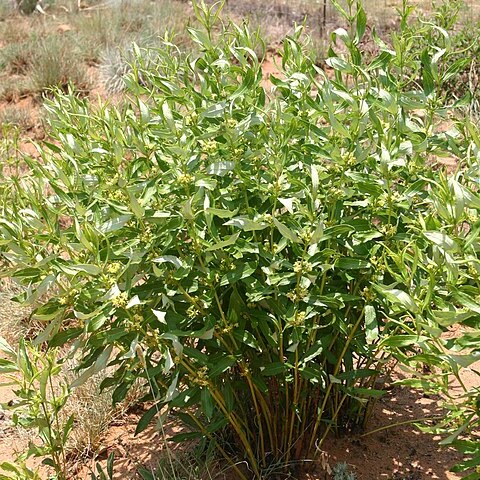Ramis erectis, usque 50 cm altis, foliis 4-verticillatis, elliptico-lanceolatis, subsessilibus, basi cuneatis, apice cuneato-acuminatis, supra glabris, infra breviter tomentosis, nervis lateralibus I circ. utrinque 8-9; stipulis lanceolatis, lobis liberis usque 13 mm longis; floribus axillaribus fasciculatis, breviter pedicellatis, pedicellis usque 4 mm longis; calyce glabro, tubo circ. 1.5 mm longo, lobis lanceolatis, acutis 3 mm longis; tubo corollae circ. 4 mm longa, lobis refractis circ. 4 mm longis, glabris acutis; staminibus parce exsertis, stylo glabro, stigmato calyptritormi. circ. 1 mm longo.
Leaves in whorls of 3–5, markedly discolorous; 2.2–12 × 0.3–3.8 cm, narrowly elliptic or oblong-lanceolate to lanceolate, tapering to a fine acute apex, cuneate at the base, green and glabrous above, drying whitish-tomentose beneath due to a very dense covering of minute papilla-like hairs, pale green in life; petiole 1–2.5 mm long; stipules joined to form a sheath 1.5–3 mm long with 3 filiform appendages 5–8 mm long.
Corolla distinctly 5–6-apiculate at the apex in bud, the appendages diverging; yellowish or bright yellow; tube 3–4(5) mm long, with ring of deflexed hairs inside; lobes 4–5.5 × 2 mm, narrowly triangular or oblong-triangular, drawn out at the apex into a subulate appendage, 1–1.5 mm long.
A erect woody shrub. It grows 30-120 cm tall. There are 3-4 stems coming from a slender underground stem or rhizome. The leaves are in rings of 3-5. They are simple and 2-12 cm long by 1-4 cm wide. The flowers are in groups of 2-5. The fruit are black and 6-10 mm long.
Perennial herb, up to 500 mm tall. Leaves discolorous, lower surface densely white papillate, upper surface green and glabrous. Calyx lobes triangular-lanceolate, 2.0-3.5 mm long. Corolla tube 3-4 mm long. Flowers yellowish green.
Erect suffrutex 30–120 cm tall, with 3–4 or many stems from a slender rhizome; stems often reddish, 3–4-angled, glabrous or rarely very sparsely pubescent.
Fruit black, crowned with the persistent calyx limb, often oblique, 6–10(13) mm long, usually with 2–3 pyrenes.
Inflorescences 2–5-flowered, glabrous; peduncle 3–4 mm long; pedicels 1.5–6 mm long.
Calyx tube 1.2–1.5 mm long; limb with triangular to lanceolate teeth 1–3.5 mm long.
Pollen presenter coroniform, 1–1.5 mm long, 3–4-lobed.
Style rather stout, about 7 mm long.
Ovary 3–4-locular.

